Analysis of Evolving Carbon Stock Trends and Influencing Factors in Chongqing under Future Scenarios
Abstract
1. Introduction
2. Methodology
2.1. Overview of the Study Area
2.2. Data Sources
2.3. Research Methods
2.3.1. PLUS Model for Future Land Use Type Data Simulation
2.3.2. InVEST Model for Carbon Storage Calculation
2.3.3. Geographic Detector
3. Results and Analysis
3.1. Analysis of Land Use Simulation Accuracy and Results in Chongqing
3.1.1. Analysis of PLUS Model Simulation Accuracy
3.1.2. Analysis of Current Land Use Structure
3.1.3. Analysis of Simulated Land Use Scenario Results
3.2. Carbon Storage Evolution Quantitative Analysis
3.2.1. Analysis of Carbon Storage Evolution Trends in Chongqing
3.2.2. Evolving Carbon Storage Trends in Various Districts and Counties of Chongqing
3.3. Analysis of Carbon Storage Spatiotemporal Evolution Characteristics
3.3.1. Analysis of Carbon Storage Spatial Aggregation Characteristics
3.3.2. Analysis of Carbon Storage Spatiotemporal Change Patterns
4. Discussion
4.1. Impact of Land Use Change on Carbon Storage
4.2. Factors Affecting Carbon Storage
4.3. Limitations and Perspectives
5. Conclusions
- The PLUS model is suitable for simulating land use type data at a 30-m resolution in Chongqing (with a Kappa coefficient above 0.85 and an overall accuracy above 0.90). Over the study period, significant changes occurred in the area of each land use type in Chongqing. Cropland and grassland showed a continuous decrease, while construction and water bodies exhibited an increasing trend. Forested land and other land use types displayed fluctuating changes. Under the ED scenario, the areas of forested land and cropland were larger than those under the ND scenario, while the area of construction was smaller under the EP scenario.
- The total carbon storage in Chongqing exhibited an overall decreasing trend, with a decrease of 10.07 × 106 t C from 2000 to 2020. Under the ND scenario, the carbon storage in 2030 decreased by 10.54 × 106 t C compared to 2020, while under the ED scenario, the carbon storage in 2030 was 2.38 × 106 t C higher than that under the ND scenario. From 2030 to 2050, carbon storage began to stabilize. The areas with the highest carbon storage in 2000 were Youyang, Fengjie, and Wuxi (80.75 × 106 t C, 63.19 × 106 t C, 62.32 × 106 t C, respectively), while those with the lowest carbon storage were Nanchuan, Jiangbei, and Dadukou (3.16 × 106 t C, 2.62 × 106 t C, 1.21 × 106 t C, respectively). The trends in carbon storage rankings were consistent with those in the year 2000. Ecological protection scenarios were beneficial for slowing the decline in carbon storage, and future carbon storage will gradually stabilize as the speed of construction expansion slows, contributing to achieving the “dual carbon” goals.
- Carbon storage hotspots exhibited characteristics of “eastern hotspot clustering” and “western cold spot clustering”. Cold spots were mainly distributed in economically developed urban areas such as Jiangbei, Yubei, and Banan, as well as parts of Dianjiang, Liangping, and Wanzhou. Hotspots were mainly concentrated in forest-rich mountainous areas like Daba Mountain, Qiyao Mountain, Wuling Mountain, and Da Luo Mountain. From 2000 to 2010 and from 2010 to 2020, the proportions of areas with decreased, unchanged, and increased carbon storage aggregation in Chongqing were 2.99%, 95.95%, 1.06%, and 4.39%, 92.40%, 3.21%, respectively. Overall, carbon storage exhibited a decreasing trend in aggregation, and future carbon storage will gradually stabilize.
- Changes in land use types had a significant impact on carbon storage. Elevation, terrain fluctuation, annual average temperature, and nighttime light index had the greatest impact on carbon storage, while different combinations of these factors exerted even more substantial influence. Enhancing carbon storage requires considering ecological priorities and adopting a green development philosophy to comprehensively improve regional development conditions, achieving stable and improved carbon storage and promoting the realization of “dual carbon” goals.
Author Contributions
Funding
Institutional Review Board Statement
Informed Consent Statement
Data Availability Statement
Conflicts of Interest
References
- Tian, C.S.; Qi, L. Empirical Decomposition and Peaking Path of Carbon Emissions in Resource-Based Areas. J. Clean. Prod. 2023, 395, 136372. [Google Scholar] [CrossRef]
- Adams, A.B.; Pontius, J.; Galford, G.L.; Merrill, S.C.; Gudex-Cross, D. Modeling Carbon Storage across a Heterogeneous Mixed Temperate Forest: The Influence of Forest Type Specificity on Regional-Scale Carbon Storage Estimates. Landsc. Ecol. 2018, 33, 641–658. [Google Scholar] [CrossRef]
- Rodriguez Martin, J.A.; Alvaro-Fuentes, J.; Gonzalo, J.; Gil, C.; Ramos-Miras, J.J.; Corbi, J.M.G.; Boluda, R. Assessment of the Soil Organic Carbon Stock in Spain. Geoderma 2016, 264, 117–125. [Google Scholar] [CrossRef]
- Volkova, L.; Roxburgh, S.H.; Weston, C.J. Effects of Prescribed Fire Frequency on Wildfire Emissions and Carbon Sequestration in a Fire Adapted Ecosystem Using a Comprehensive Carbon Model. J. Environ. Manag. 2021, 290, 112673. [Google Scholar] [CrossRef] [PubMed]
- Bultan, S.; Nabel, J.E.M.S.; Hartung, K.; Ganzenmuller, R.; Xu, L.; Saatchi, S.; Pongratz, J. Tracking 21st Century Anthropogenic and Natural Carbon Fluxes through Model-Data Integration. Nat. Commun. 2022, 13, 5516. [Google Scholar] [CrossRef] [PubMed]
- Gonzalez-Garcia, A.; Arias, M.; Garcia-Tiscar, S.; Alcorlo, P.; Santos-Martin, F. National Blue Carbon Assessment in Spain Using Invest: Current State and Future Perspectives. Ecosyst. Serv. 2022, 53, 101397. [Google Scholar] [CrossRef]
- Zarandian, A.; Badamfirouz, J.; Musazadeh, R.; Rahmati, A.; Azimi, S.B. Scenario Modeling for Spatial-Temporal Change Detection of Carbon Storage and Sequestration in a Forested Landscape in Northern Iran. Environ. Monit. Assess. 2018, 190, 474. [Google Scholar] [CrossRef] [PubMed]
- Imran, M.; Din, N.U. Geospatially Mapping Carbon Stock for Mountainous Forest Classes Using Invest Model and Sentinel-2 Data: A Case of Bagrote Valley in the Karakoram Range. Arab. J. Geosci. 2021, 14, 756. [Google Scholar] [CrossRef]
- Nouri, J.; Gharagozlou, A.; Arjmandi, R.; Faryadi, S.; Adl, M. Predicting Urban Land Use Changes Using a Ca-Markov Model. Arab. J. Sci. Eng. 2014, 39, 5565–5573. [Google Scholar] [CrossRef]
- Lamichhane, S.; Shakya, N.M. Land Use Land Cover (Lulc) Change Projection in Kathmandu Valley Using the Clue-S Model. J. Adv. Coll. Eng. Manag. 2021, 6, 221–233. [Google Scholar] [CrossRef]
- Liang, X.; Guan, Q.F.; Clarke, K.C.; Liu, S.S.; Wang, B.Y.; Yao, Y. Understanding the Drivers of Sustainable Land Expansion Using a Patch-Generating Land Use Simulation (Plus) Model: A Case Study in Wuhan, China. Comput. Environ. Urban Syst. 2021, 85, 101569. [Google Scholar] [CrossRef]
- Zhu, K.W.; He, J.; Zhang, L.X.; Song, D.; Wu, L.J.; Liu, Y.Q.; Zhang, S. Impact of Future Development Scenario Selection on Landscape Ecological Risk in the Chengdu-Chongqing Economic Zone. Land 2022, 11, 964. [Google Scholar] [CrossRef]
- Yang, S.; Su, H. Multi-Scenario Simulation of Ecosystem Service Values in the Guanzhong Plain Urban Agglomeration, China. Sustainability 2022, 14, 8812. [Google Scholar] [CrossRef]
- Babbar, D.; Areendran, G.; Sahana, M.; Sarma, K.; Raj, K.; Sivadas, A. Assessment and Prediction of Carbon Sequestration Using Markov Chain and Invest Model in Sariska Tiger Reserve, India. J. Clean. Prod. 2020, 278, 123333. [Google Scholar] [CrossRef]
- Qacami, M.; Khattabi, A.; Lahssini, S.; Rifai, N.; Meliho, M. Land-Cover/Land-Use Change Dynamics Modeling Based on Land Change Modeler. Ann. Reg. Sci. 2022, 70, 237–258. [Google Scholar] [CrossRef]
- Kusi, N.L.S. Prospective Evaluation of the Impact of Land Use Change on Ecosystem Services in the Ourika Watershed, Morocco. Land Use Policy 2020, 97, 104796. [Google Scholar] [CrossRef]
- Pechanec, V.; Purkyt, J.; Benc, A.; Nwaogu, C.; Sterbova, L.; Cudlin, P. Modelling of the Carbon Sequestration and Its Prediction under Climate Change. Ecol. Inform. 2018, 47, 50–54. [Google Scholar] [CrossRef]
- Zhang, Z.H.; Song, Y.Z.; Wu, P. Robust Geographical Detector. Int. J. Appl. Earth Obs. Geoinf. 2022, 109, 102782. [Google Scholar] [CrossRef]
- Luo, W.; Jasiewicz, J.; Stepinski, T.; Wang, J.F.; Xu, C.D.; Cang, X.Z. Spatial Association between Dissection Density and Environmental Factors over the Entire Conterminous United States. Geophys. Res. Lett. 2016, 43, 692–700. [Google Scholar] [CrossRef]
- Xiang, S.J.; Wang, Y.; Deng, H.; Yang, C.M.; Wang, Z.F.; Gao, M. Response and Multi-Scenario Prediction of Carbon Storage to Land Use/Cover Change in the Main Urban Area of Chongqing, China. Ecol. Indic. 2023, 142, 109205. [Google Scholar] [CrossRef]
- Liu, C.X.; Wang, C.X.; Li, Y.C.; Wang, Y. Spatiotemporal Differentiation and Geographic Detection Mechanism of Ecological Security in Chongqing, China. Glob. Ecol. Conserv. 2022, 35, e02072. [Google Scholar] [CrossRef]
- Mao, Y.F.; Zhou, Q.G.; Wang, T.; Luo, H.R.; Wu, L.J. Spatial–Temporal Variation of Carbon Storage and Its Quantitative Attribution in the Three Gorges Reservoir Area Coupled with PLUS—InVEST Geodector Model. Resour. Environ. Yangtze Basin 2023, 32, 1042–1057. [Google Scholar]
- Yu, Y.; Guo, B.; Wang, C.L.; Zang, W.Q.; Huang, X.Z.; Wu, Z.W.; Xu, M.; Zhou, K.D.; Li, J.L.; Yang, Y. Carbon Storage Simulation and Analysis in Beijing-Tianjin-Hebei Region Based on Ca-Plus Model under Dual-Carbon Background. Geomat. Nat. Hazards Risk 2023, 14, 2173661. [Google Scholar] [CrossRef]
- Li, Y.X.; Liu, Z.S.; Li, S.J.; Li, X. Multi-Scenario Simulation Analysis of Land Use and Carbon Storage Changes in Changchun City Based on Flus and Invest Model. Land 2022, 11, 647. [Google Scholar] [CrossRef]
- Wan, Q.L.; Shao, J.A. Land Use and Carbon Storage Estimation in Chongqing Section of the Three Gorges Reservoir Area from 2000 to 2020. J. Chongqing Norm. Univ. 2023, 40, 1–11. [Google Scholar]
- Song, Y.Z.; Wang, J.F.; Ge, Y.; Xu, C.D. An Optimal Parameters-Based Geographical Detector Model Enhances Geographic Characteristics of Explanatory Variables for Spatial Heterogeneity Analysis: Cases with Different Types of Spatial Data. GISci. Remote Sens. 2020, 57, 593–610. [Google Scholar] [CrossRef]
- Bai, H.X.; Li, D.Y.; Ge, Y.; Wang, J.F.; Cao, F. Spatial Rough Set-Based Geographical Detectors for Nominal Target Variables. Inf. Sci. 2022, 586, 525–539. [Google Scholar] [CrossRef]
- Li, W.; Geng, J.W.; Bao, J.L.; Lin, W.X.; Wu, Z.Y.; Fan, S.S. Analysis of Spatial and Temporal Variations in Ecosystem Service Functions and Drivers in Anxi County Based on the Invest Model. Sustainability 2023, 15, 10153. [Google Scholar] [CrossRef]
- Ren, B.Y.; Wang, Q.F.; Zhang, R.R.; Zhou, X.Z.; Wu, X.P.; Zhang, Q. Assessment of Ecosystem Services: Spatio-Temporal Analysis and the Spatial Response of Influencing Factors in Hainan Province. Sustainability 2022, 14, 9145. [Google Scholar] [CrossRef]
- Kiran, K.T.M.; Pal, S.; Chand, P.; Kandpal, A. Carbon Sequestration Potential of Agroforestry Systems in Indian Agricultural Landscape: A Meta-Analysis. Ecosyst. Serv. 2023, 62, 101537. [Google Scholar]

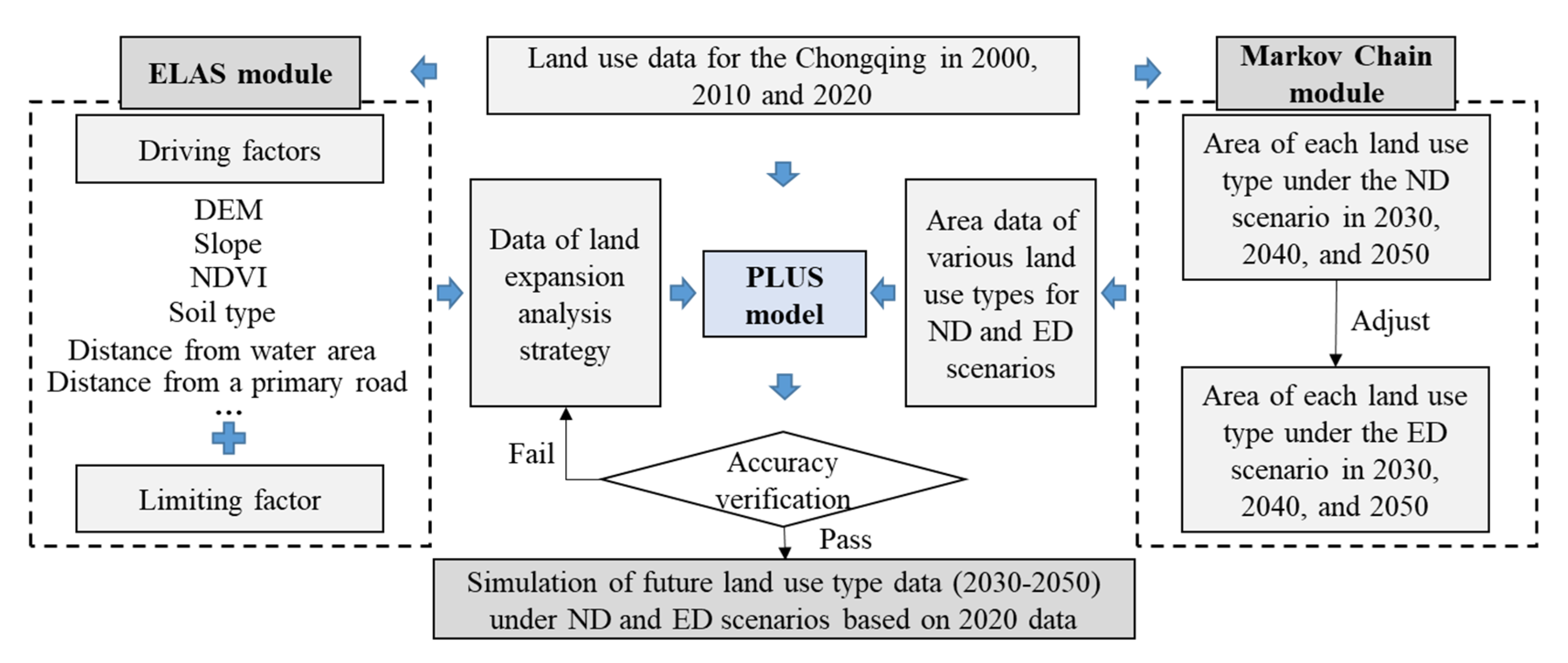
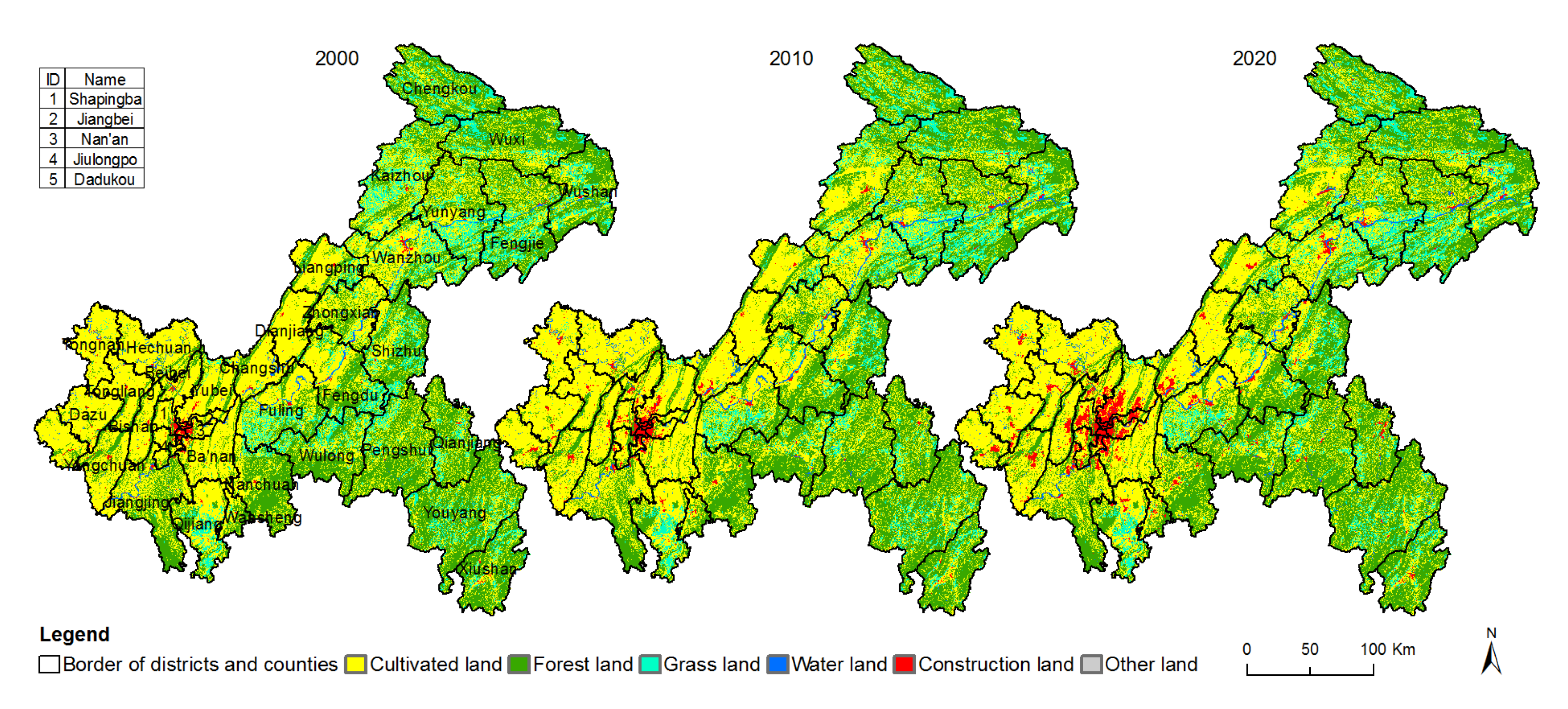
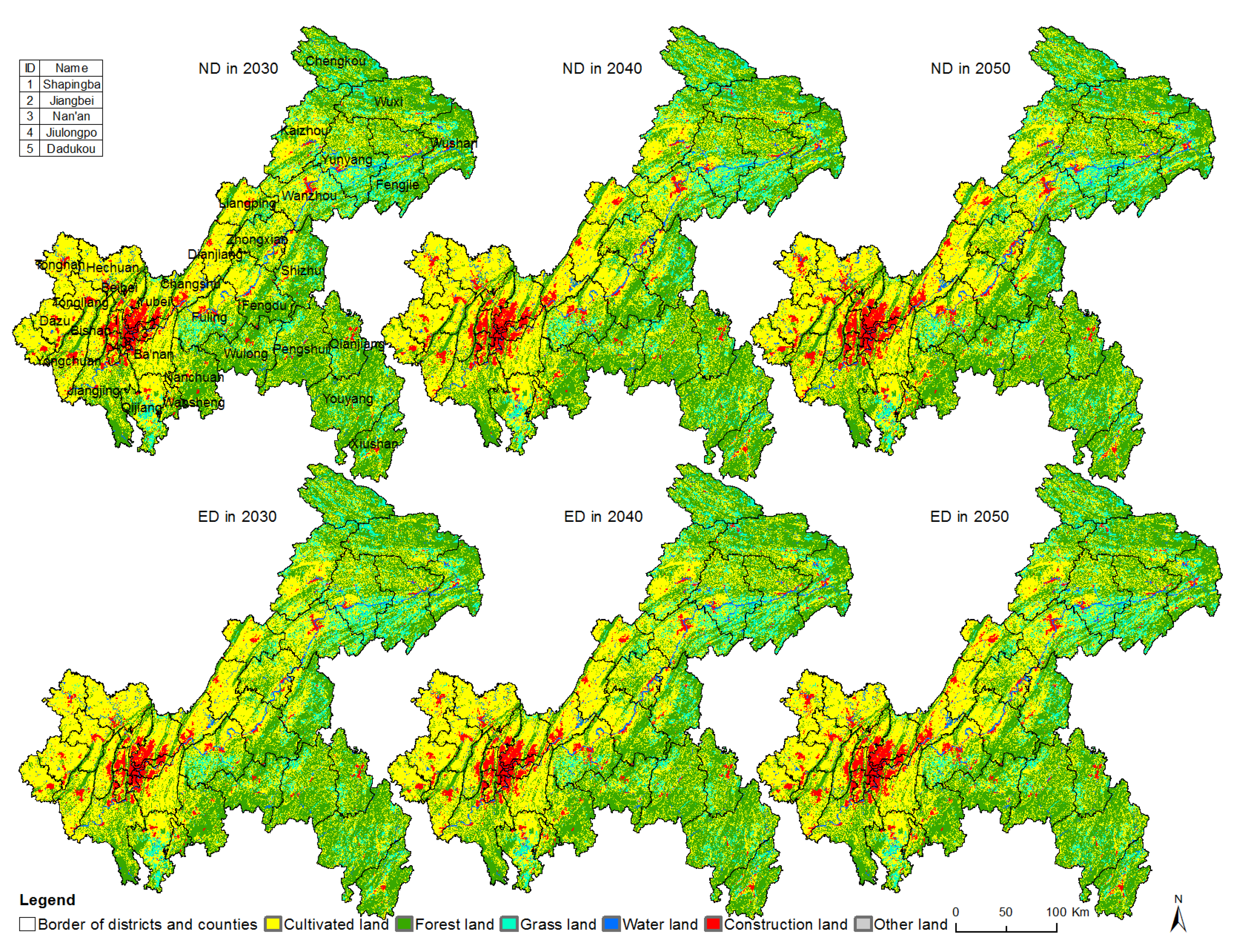
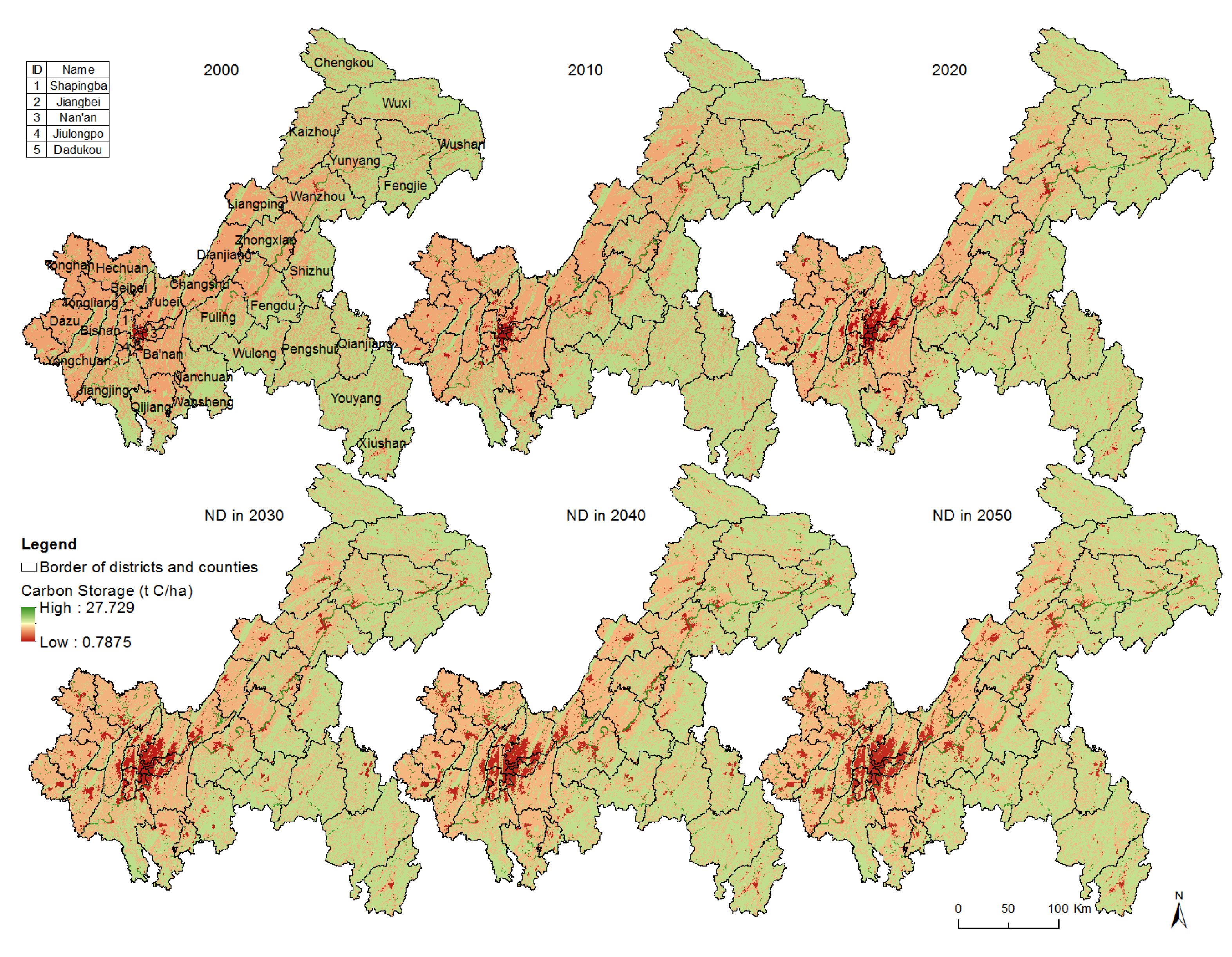
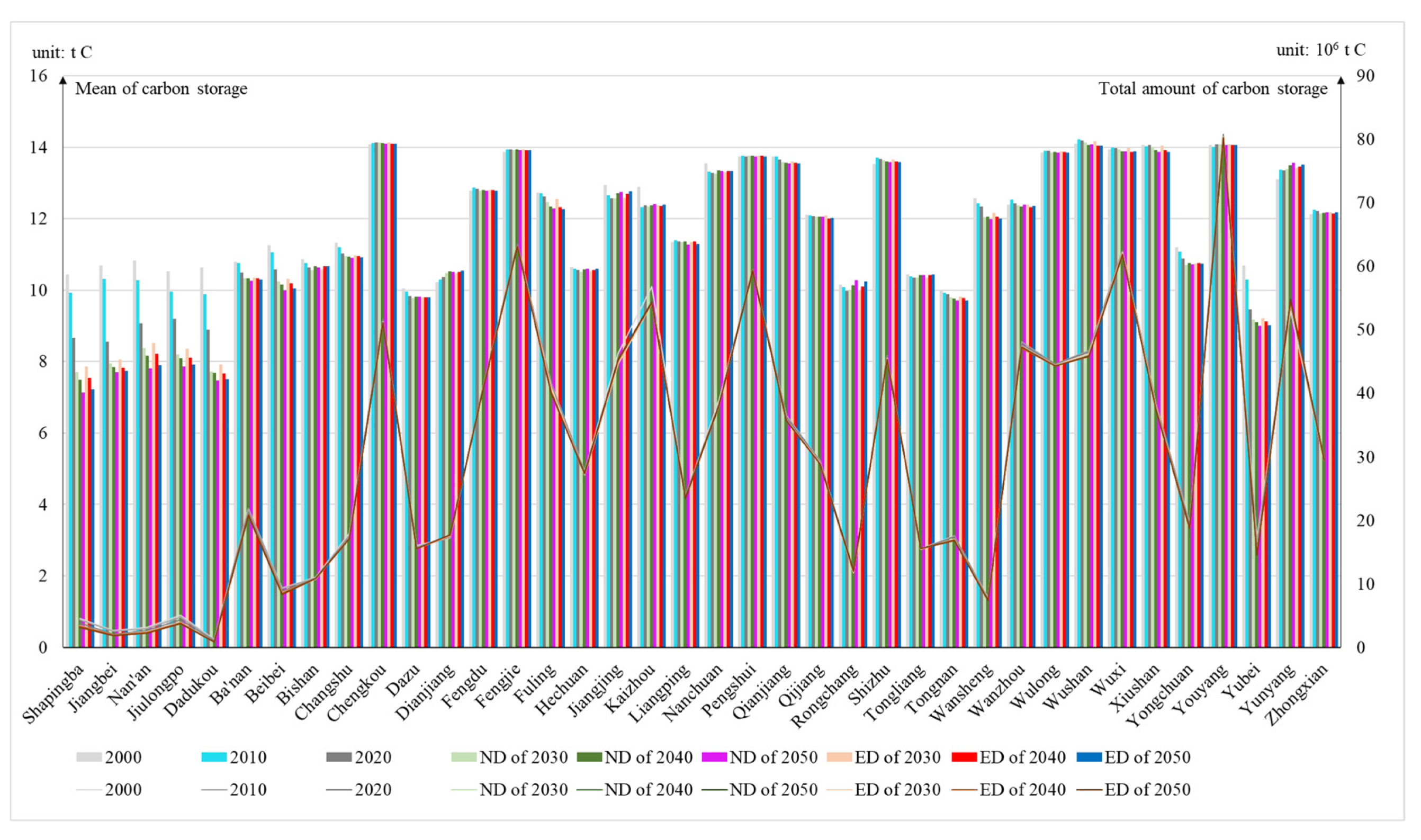
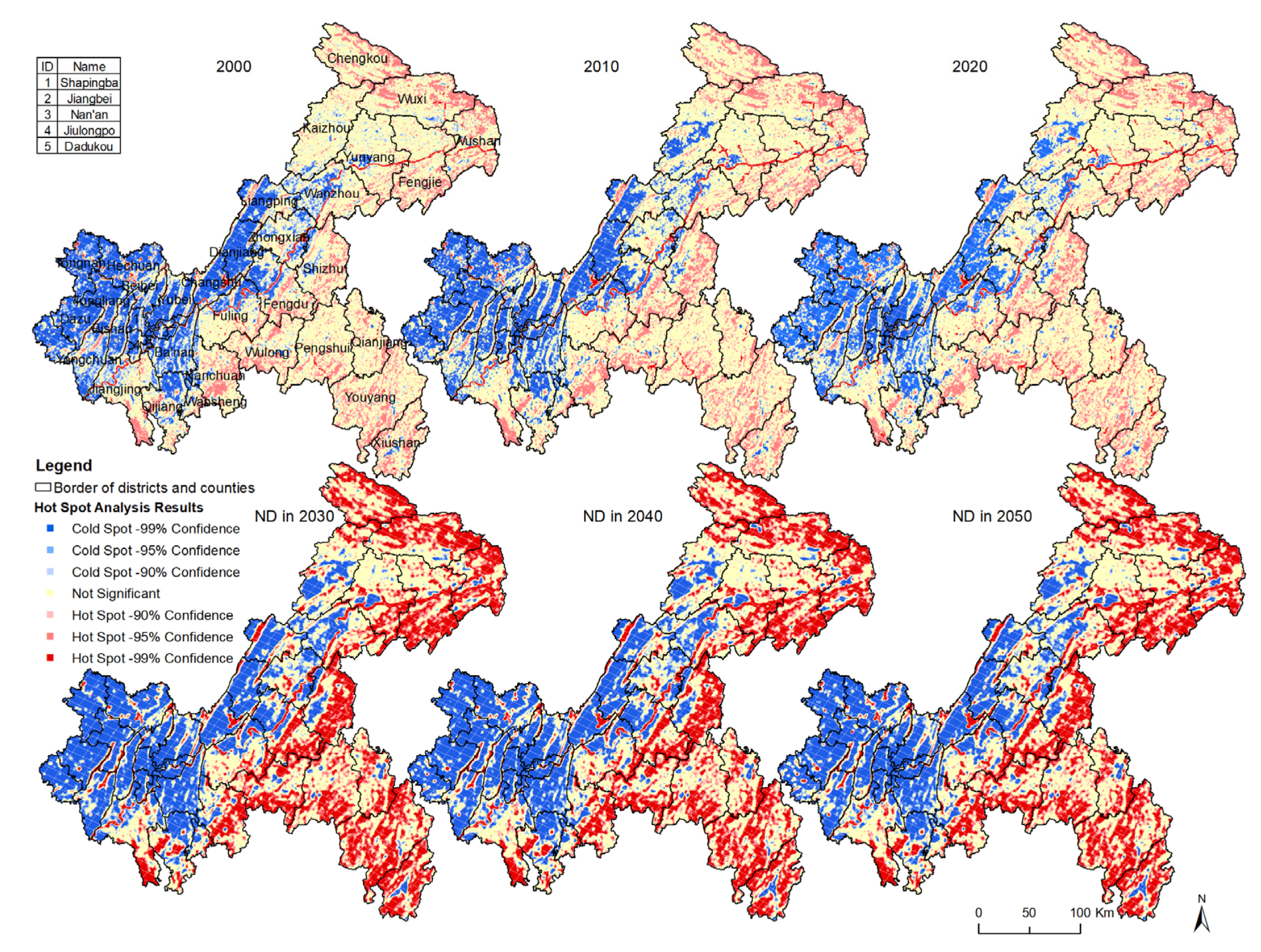
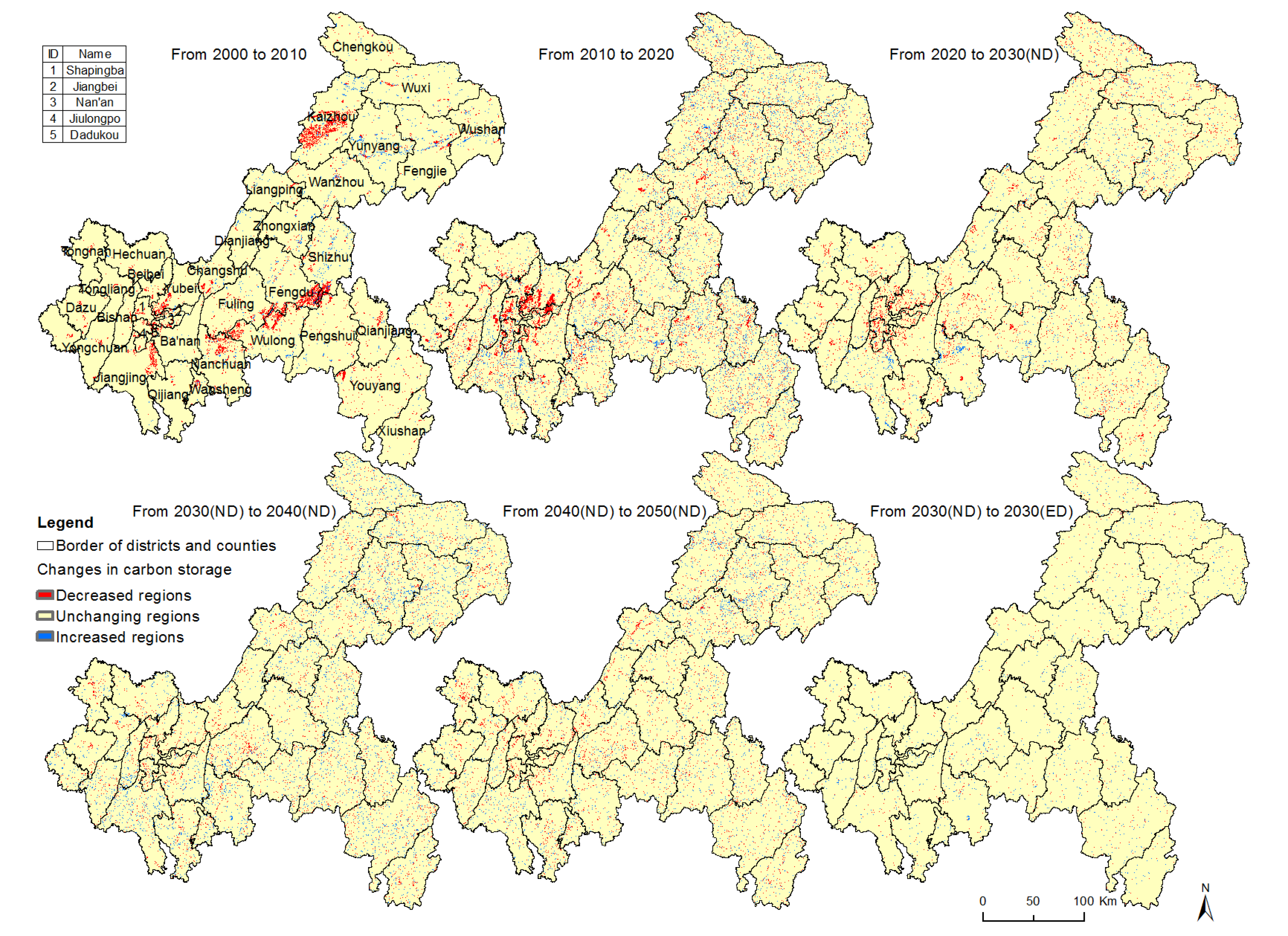

| Land Use Types | Ground Carbon Density | Underground Carbon Density | Soil Carbon Density | Death Carbon Density |
|---|---|---|---|---|
| Cultivated land | 0.345 | 0.068 | 9.580 | 0.350 |
| Forest land | 4.590 | 1 | 11.540 | 0.283 |
| Grass land | 0.100 | 0.250 | 17.050 | 0.017 |
| Water land | 0.190 | 1.380 | 29.240 | 0 |
| Construction land | 0 | 0 | 2.525 | 0 |
| Other land | 0.050 | 0 | 0.825 | 0 |
| Interactive Factors | X1 | X2 | X3 | X4 | X5 | X6 |
|---|---|---|---|---|---|---|
| X1 | 0.88 | |||||
| X2 | 0.97 | 0.81 | ||||
| X3 | 0.97 | 0.90 | 0.61 | |||
| X4 | 0.97 | 0.98 | 1 | 0.87 | ||
| X5 | 0.96 | 0.97 | 0.90 | 1 | 0.77 | |
| X6 | 0.98 | 0.98 | 0.95 | 0.99 | 1 | 0.81 |
Disclaimer/Publisher’s Note: The statements, opinions and data contained in all publications are solely those of the individual author(s) and contributor(s) and not of MDPI and/or the editor(s). MDPI and/or the editor(s) disclaim responsibility for any injury to people or property resulting from any ideas, methods, instructions or products referred to in the content. |
© 2024 by the authors. Licensee MDPI, Basel, Switzerland. This article is an open access article distributed under the terms and conditions of the Creative Commons Attribution (CC BY) license (https://creativecommons.org/licenses/by/4.0/).
Share and Cite
Zhu, K.; He, J.; Tian, X.; Hou, P.; Wu, L.; Guan, D.; Wang, T.; Huang, S. Analysis of Evolving Carbon Stock Trends and Influencing Factors in Chongqing under Future Scenarios. Land 2024, 13, 421. https://doi.org/10.3390/land13040421
Zhu K, He J, Tian X, Hou P, Wu L, Guan D, Wang T, Huang S. Analysis of Evolving Carbon Stock Trends and Influencing Factors in Chongqing under Future Scenarios. Land. 2024; 13(4):421. https://doi.org/10.3390/land13040421
Chicago/Turabian StyleZhu, Kangwen, Jun He, Xiaosong Tian, Peng Hou, Longjiang Wu, Dongjie Guan, Tianyu Wang, and Sheng Huang. 2024. "Analysis of Evolving Carbon Stock Trends and Influencing Factors in Chongqing under Future Scenarios" Land 13, no. 4: 421. https://doi.org/10.3390/land13040421
APA StyleZhu, K., He, J., Tian, X., Hou, P., Wu, L., Guan, D., Wang, T., & Huang, S. (2024). Analysis of Evolving Carbon Stock Trends and Influencing Factors in Chongqing under Future Scenarios. Land, 13(4), 421. https://doi.org/10.3390/land13040421









